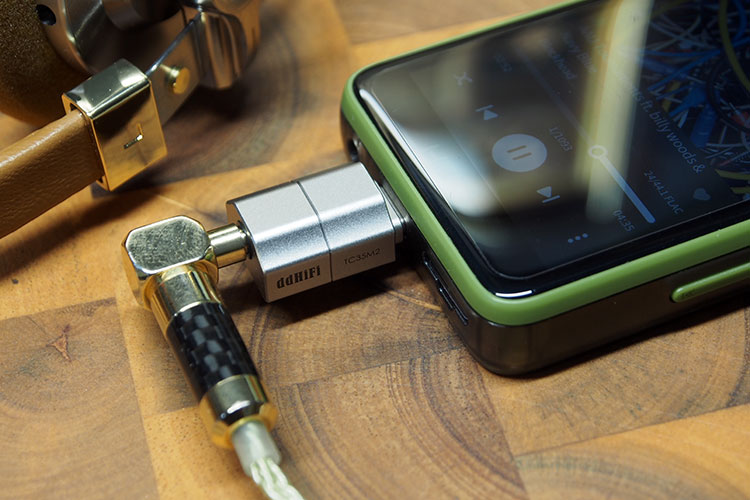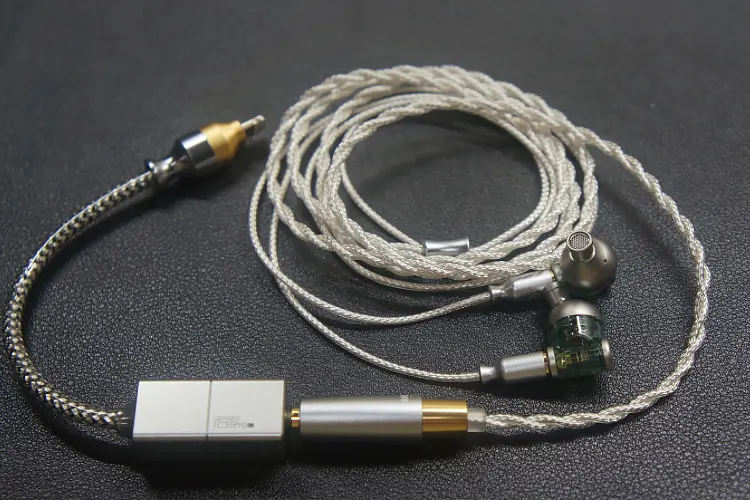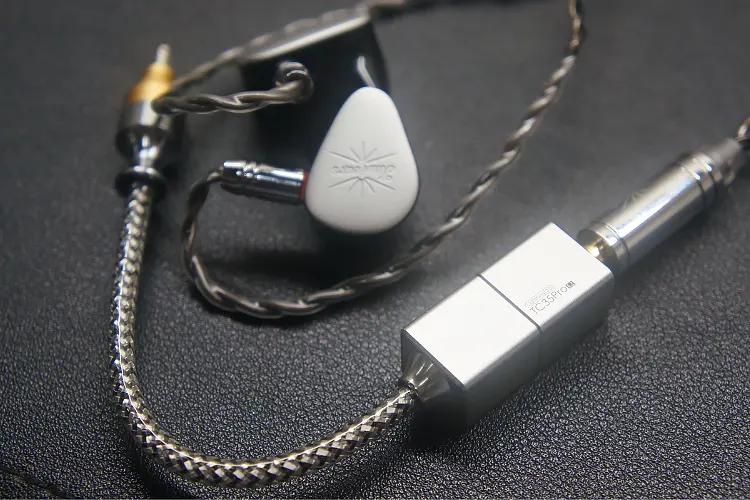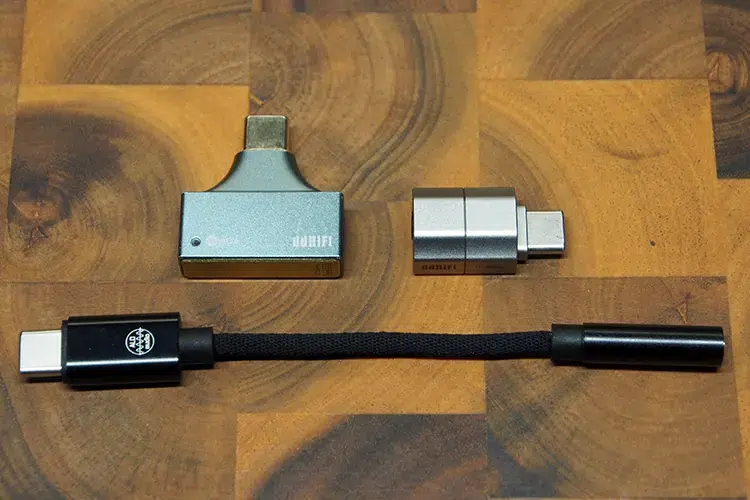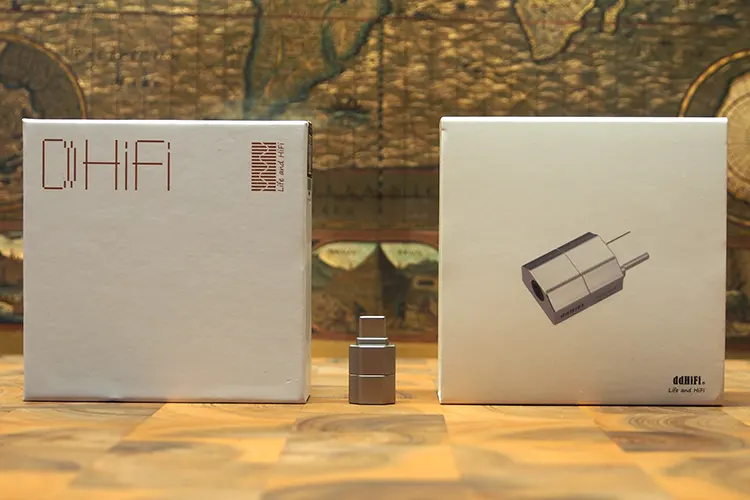Select Comparisons
ddHiFi TC35 Pro
Technical
The TC35M2 provides PCM decoding up to 384kHz at 32 bits. The TC35 Pro provides PCM decoding up to 768kHz at 32 bits with DSD 512 and MQA support. The KA15 utilizes an ES9603Q DAC. The TC35 Pro uses an ES9281AC DAC.
On the TC35M2, the power output is 45mW @32Ω. The TC35 Pro outputs up to 62mW @32Ω.
To compare the volume output, I set my Huawei P40’s volume to 50% and found the TC35M2 was louder despite lower power ratings. The TC35 Pro better modulated volume levels at the extremes and was more versatile when pairing it with more sensitive or demanding gear.
Design
Both models have full metal bodies with simple but interesting designs and should you tip the TC35 Pro upside-down and squint, it’s kind of shaped like a mountain, hence the name.
The TC35M2 is quite a bit smaller, taking up about as much space as the rear half of the TC35 Pro, which happens to be where the 3.5mm plug is on that model.
On the TC35M2, the plug lines up with the Type-C port, while it lays perpendicular to the Type-C port on the TC35 Pro.
I prefer the perpendicular layout as it shrinks the effective footprint of the total package, and when sticking a phone or DAP in your pocket with a micro-DAC like these two attached, a smaller footprint is welcome.
It helps ensure that, should you bend, fall, or fold in half for any other reason, you’re less likely to damage any part of your kit.
In addition to the laser-etched logo and branding details on both models, the TC35 Pro contains some additional features and design queues.
On the rear of the device is a contrasting gold plate that adds some visual flair missing from the TC35M2, and on top a small LED that changes color to advise the file quality.
The TC35M2 and TC35 Pro are handsome devices, but my tastes have me preferring the design of the TC35 Pro. The vertical plug orientation and contrasting gold plate win me over from both function and design perspectives.
Performance
The TC35 Pro is a more premium device, and despite being older, it sounds like it. Although its signature skews slightly towards the low end, it is still more balanced than the bright-leaning nature of the TC35M2.
In the treble region, the TC35 Pro is smoother, though detail levels are on par. The TC35M2 also does a better job of bringing out the brilliance region, resulting in a more energetic and lively presentation.
The midrange of the TC35 Pro is slightly leaner and more detailed with better clarity. The TC35M2’s mids are more forward though, and I found that this gave drums more presence and an overall more appealing and confident presentation.
The bass out of the TC35 Pro is more mid-bassy and warmer with slightly improved extension. In most situations, however, the differences between the two are minimal, though the attack out of the TC35M2 was more impactful.
Staging from the TC35M2 is smaller with a default vocal presentation that lays closer to the ear. The wider bass floor of the TC35 Pro also helps improve the overall staging size.
I didn’t notice much difference in the way they imaged with sounds sweeping channel-to-channel smoothly and without any oddities. Mostly the same can be said for layering and separation qualities, though the larger stage of the TC35 Pro offers a minute advantage here.
ALO Audio Pilot
Technical
The TC35M2 provides PCM decoding up to 384kHz at 32 bits. The Pilot provides PCM decoding up to 384kHz at 32 bits with DSD 128 and MQA support.
The Pilot utilizes an ES9281C Pro DAC. The TC35 Pro uses an ES9281AC DAC.
On the TC35M2, the power output is 45mW @ 32Ω. The Pilot outputs 50mW @ 16Ω, and 14mW @ 300Ω. I was unable to locate equivalent impedance power values.
To compare the volume output, I set my Huawei P40’s volume to 50% and found the TC35M2 was quieter. While neither was good with sensitive earphones at low volumes, the TC35M2 was slightly better, with high-volume performance going to the Pilot.
Design
These two DACs take very different approaches to their designs. The Pilot has a more traditional design, with the 3.5mm port separated from the main body of the device by a ~2-inch cloth-wrapped cable.
Both port receptacles are metal sheathed and painted black. This gives the Pilot a more downplayed, stealthy look.
In contrast, the TC35M2 contains everything in one unit that is only a little bigger than the Type-C end of the Pilot. The silver coloring is also considerably more interesting visually.
The build quality on the pair is quite good, though I’ll have to give it to the TC35M2. Fewer parts and everything contained in one dense package gives me more confidence, especially since I find the design of the Pilot to catch on to things and regularly break the connection with the source device, pausing my music.
Overall, I much prefer the design of the TC35M2 over the Pilot, whether looking at them from design or usability perspectives. However, the LED indicator for file resolution is a nice touch on the Pilot.
Performance
In contrast to the brighter sound of the TC35M2, the Pilot is more neutral with a minor low-end bump that gives it a warmer presentation.
In the treble, the Pilot provides a more refined presentation with similar levels of detail and clarity. I found the TC35M2’s brilliance region to be more extended and energetic which helped darker earphones more than the Pilot’s tuning.
The TC35M2’s mids are more forward with a similar level of detail and clarity. Neither is particularly amazing in this region, but both offer a pleasing, natural timbre.
The bass out of the Pilot is stronger with more mid-bass emphasis that can result in slightly boomy hits on tracks that are already heavy-handed in the low end. While the TC35M2 doesn’t reach quite as deep, I prefer the texturing and snappiness it presents.
Staging between the two was identical to my ears. The vocal positioning, imaging accuracy, instrument layering, and instrument separation were indistinguishable as I swapped between the two.
My Verdict
As a DAC, the TC35M2 is imperfect. The midrange could benefit from more detail, it’s too loud at low volumes for overly sensitive gear, and there is potential for distortion when tossing something exceptionally demanding its way.
The general tuning is good, though skewed towards the upper ranges in a way that makes it best paired with neutral to bass-biased products. However, if you keep in mind its limitations the TC35M2 is a fantastic product.
The power output is more than enough for most commonly purchased gear and you’re not paying much of a premium for the size. And the size is what you buy the TC35M2 for in my opinion.
Given the TC35M2 is no larger than your average 3.5mm plug, and smaller than some, it’s completely unintrusive. You can leave your headphones or IEMs plugged in at all times, almost treating it like a “dumb” adapter.
You don’t have to deal with dangly cables or fine-tuning your settings either. You just plug in and go, which is what I want 99% of the time when I’m listening to music outside of a curated environment.
This is something I’m going to be using all the time, but not because it’s the best sounding or the most feature-packed. It’s because the TC35M2 is infinitely more convenient to use than more conventionally designed DACS.
ddHiFi TC35M2 Technical Specifications
- Plug: USB-C
- Socket: 3.5mm four-section
- Frequency Response: 20Hz-20kHz
- Amplifier Chip: ES9603Q (independent)
- Output Power: L + R ≥ 45mW + 45mW (32Ω / THD + N <1%)
- Signal-to-Noise Ratio: ≥ 112dB (32Ω load / A-weighting)
- Dynamic Range: >120dB
- Total Harmonic Distortion: <0.008% (32Ω load)
- Bottom Noise: <3μV (A-weighted)
- PCM Decoding Support: Up to 32bit/384kHz
- Support for In-Line Headphone Type: CTIA in-line standard
- Dimensions: 17.8 × 14 × 8.9 mm
- Weight: About 3.6g

